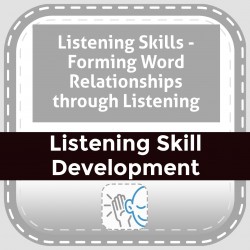
Categories
Resource Types
CCSS
Speaking & Listening
Language
Reading
Language - Syntax Grammar - Recognizing Phrases
$ 195
A phrase supports the structure of a sentence. It can act as a noun, an adjective, a preposition, or an adverb. The function depends upon the structure and placement in the sentence. Use these activit
...
ies with students who are learning parts of speech. This can also serve to enhance descriptive vocabulary.
Language - Intensity by Degree 1
$ 195
Explains that intensity represents a change in complexity for any area of learning. Uses visualizing, rating scales, sequencing, and graphic organizers.
Language - Intensity by Degree 2
$ 195
Explains that intensity represents a change in complexity for any area of learning. Uses visualizing, rating scales, sequencing, and graphic organizers.
Language - Before and After
$ 2
As part of understanding routine, a student needs to recognize and use the prepositions ‘before’ and ‘after’ effectively to demonstrate sequence of events. This activity is organized from simple to co
...
le to complex language structure.
Language - Adverbs - Gently, Merrily, Down the Stream!
$ 295
Describes how adjectives help us more clearly visualize the action in a sentence. Includes adverb book lists, activities, adverb word bank, Tom Swifty jokes with adverb punchlines, and 8 worksheets to
...
develop use of adverbs in speech and writing. Gives an adverb rubric and sample IEP goals.
Language Strategies - Compare and Contrast
$ 395
An explanation of why students should be encouraged to find similarities and differences in language and stories; worksheets include: categorizing objects by their attributes; findings similarities an
...
d differences in pictures; survey similarities and differences in friends and chart on Venn diagram; synonym/antonym task cards; simile/metaphor task cards; contrasts and comparisons in reading comprehension passage.
Language - Intensity by Degree - BUNDLE
$ 195
Explains that intesity represents a change in complexity for any area of learning. Uses visualizing, rating scales, sequencing, and graphic organizers.Uses word choice to show degree of intensity. In
...
cludes 2 worksheets. ID numbers 0923, 0924.
Language - Pretty Good/Good/ Really Good
$ 0
Pretty good, good, and really good are common ways to describe the intensity of appreciation for something. We use these words to quantify and qualify things in our environment. Use this page as a vo
...
cabulary or language reinforcement.
Social - Developing Word Choice for Emotions
$ 2
Gives a word bank of emotions by degree of intensity, emotions activities and instructional strategies to teach verbal expression of emotion.
Listening Skills - Forming Word Relationships through Listening
$ 0
Auditory discrimination plays a large part in listening comprehension. These listening strategies and activities can be used to practice auditory and listening skills. Includes recognizing same and d
...
ifferent, number of sounds and syllables, word association, listening comprehension, and listening for fact or opinion.

 Your browser is out of date. For best experience switch to latest updated Browser.
Your browser is out of date. For best experience switch to latest updated Browser.
 Get Chrome
Get Chrome Get Edge
Get Edge Get Firefox
Get Firefox












 You MUST include an email contact and phone number on your PO. Some of our products are downloadable only and delivered via email. Not including an email address will prevent delivery.
You MUST include an email contact and phone number on your PO. Some of our products are downloadable only and delivered via email. Not including an email address will prevent delivery. 